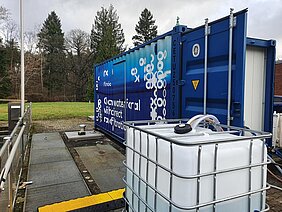Pilot studies using hollow fiber nanofiltration membranes to determine the PFAS removal depending on water composition and operation conditions.
Per- and polyfluorinated alkyl substances (PFAS) pose a significant environmental challenge due to their biochemical stability and wide range of applications. They are ubiquitous in the environment, can accumulate in various compartments, and may infiltrate groundwater. To comply with the new German Drinking Water Ordinance (2023), which sets limits for PFAS groups (PFAS-20 and PFAS-4), hollow fiber nanofiltration (NF) is a promising option for PFAS removal.
Existing treatment methods such as activated carbon adsorption, reverse osmosis, or ion ex-change can be used for PFAS removal, but they have limitations, such as low retention of short-chain PFAS, need for post-treatment, high energy demand or lack of approval for use in drinking water treatment. Membrane filtration with hollow fiber nanofiltration (NF), a modified ultrafiltration membrane with nanofiltration properties, is a promising technology for PFAS removal. It allows for higher retention of divalent ions and higher-molecular organic substances while also removing particulate matter. Due to lower concentration polarization, the use of antiscalants may be avoided, and concentrate disposal issues mitigated.
As part of the DVGW-funded R&D project W202304 “KapillO-PFAS” (July 2023 – September 2025), the technical potential and limitations of hollow fiber NF were investigated under site-specific conditions. A pilot plant with a full-scale NF module was operated for three months each at four waterworks with differing raw water compositions. Laboratory experiments compared hollow-fiber membranes with two flat-sheet membranes commonly used in spiral-wound elements regarding salt and PFAS retention.
The objective of reducing the PFAS-20 and PFAS-4 sum concentrations was met in all test runs and operating settings. For system operation with mineralized waters, the occurrence of calcium carbonate scaling can represent a challenge and may require acid dosing in the feed to lower pH value and to prevent impairment of the retention performance. Across sites, stable operation under conditions typical of large-scale systems was achieved without loss of permeability, and no antiscalant was required.
Overall, hollow-fiber NF proved effective for PFAS removal in the investigated water matrices. Further research is needed to assess economic viability, sustainability, and long-term feasibility, as well as to develop strategies for concentrate management.

![[Translate to English:] Prüfstelle-Produktprüfung_Teststand Test centre and product testing](/fileadmin/_processed_/0/9/csm_TZW-Karlsruhe_Pruefung_Geraete-Teststand_377188946c.jpg)

























